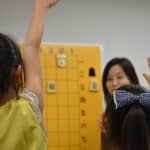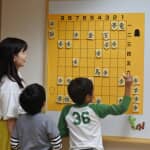Shogi 24 May 2019
Bible of Handicap Game –9 Pieces Dropped–
A series of articles named “Bible of Handicap Game” provides you a good knowledge of learning points and goals in several types of handicap games, Koma Ochi. This is the third article, which deals with a 9-piece handicap.
Koma Ochi refers to a handicap Shogi game. When players play a Koma Ochi game, a stronger player drops his/her own piece/pieces. The number of dropped pieces depends on the difference in skills. The bigger the difference is, the more pieces the player drops. Originally, Koma Ochi was introduced to make a game more fun eliminating the skills gap. Learning Koma Ochi is also very effective to understand Shogi.
Previous Related Articles:
Bible of Handicap Game –10 Pieces Dropped, without Fu (Pawn)–
Bible of Handicap Game –10 Pieces Dropped–
Bible of Handicap Game –9 Pieces Dropped–
Today’s topic is a 9-piece handicap. The difference from the previous one, Bible of Handicap Game –10 Pieces Dropped–, is that an opponent’s Gyoku (King) has one piece of Kin (Gold) on either side, 6a or 4a. In i-tsu-tsu Shogi classes, we generally leave Kin (Gold) on the square of 6a. Having additional one piece, you may find it more difficult to take Gyoku (King) than what you’ve learned before. Kin (Gold) plays an important role as a Gyoku’s (King’s) bodyguard. Adding one piece, Kin (Gold), makes the first player’s defense stronger than that of a 10-piece handicap game situation. The key point here is how to attack after you promoted Kaku (Bishop) and Hisha (Rook).
Goal to Be Achieved through Learning a 9-Piece Handicap
• Have Ryu (Promoted Rook) and Uma (Promoted Bishop) work together to aim at Kin (Gold) who is a strong protector for Gyoku (King)
• Not to let Gyoku (King) escape upward

Aim at Not Gyoku (King) but Kin (Gold)
It also applies to a 9-piece handicap game that an important point is to promote major pieces. When you aim at letting major pieces get promoted in handicap games, what you keep in your mind is to break an opponent’s camp from the area which is not protected firmly.
Under the situation of a 9-piece handicap game, basically an opponent’s Kin (Gold) will move together with Gyoku (King). I would recommend that you attack from the square of 9e or 8e using Hisha (Rook), or you first move Kaku (Bishop) to the 6f and then to the 9c on which it will promote to Uma (Promoted Bishop).

What you will do after major pieces’ promotions is to attack Kin (Gold) who is protecting Gyoku (King), using Ryu (Promoted Rook) and Uma (Promoted Bishop) as a team.
I told you before that an opponent’s Kin (Gold) will move together with Gyoku (King). It moves so as to play a role of Gyoku’s (King’s) bodyguard.
When you play a 10-piece handicap game, you directly aim at Gyoku (King). This time, you should aim at not Gyoku (King), but its bodyguard, Kin (Gold).

Let’s attack Kin (Gold), considering the work of a number-based attack. If you aim at the square of 3b, Kin (Gold) can’t move and Gyoku (King) has to escape upward.
Once you succeed in seizing Kin’s (Gold’s) work as a bodyguard, you can get the upper hand!
Make Gyoku (King) Move Downward
For children who have just started Shogi, to pass the first stage, they need to be able to promote two major pieces and break through an opponent’s camp. Now they are facing the second stage, in which they are required to attack an opponent’s Gyoku (King).
It often happens to you that you have difficulties in capturing Gyoku (King) who keeps escaping. One of possible reasons of it is that you unconsciously let Gyoku (King) escape upward. The first players always try to move Gyoku (King) upward to prevent it from being taken and play a game with that in their mind.
Because Gyoku (King) moves in all directions, it can escape freely when it is around the centre of a Shogi board. It is a general theory that when you try to checkmate, you should put a piece/pieces on a Gyoku’s (King’s) route. The piece/pieces will wait in ambush to prevent Gyoku (King) from upward escaping. Look at the picture below, which shows the situation in which Fu (Pawn) on the 2e square is successfully stopping Gyoku (King) from escaping.

You may often hear while you play Shogi, “You have to be careful not to let your opponent’s Gyoku (King) escape upward.” This is the case.
Build Up Skills
Observe the Formation of Your Opponent’s Camp
So far, I told you how to attack Kin (Gold) who protects its Gyoku (King), using two pieces of promoted major pieces. I, also, told that was the basic way in a 9-piece handicap game. But, not everyone follows the basic rules.

There might be some players who play first and make a camp with Kin (Gold) away from Gyoku (King). I told you that Kin (Gold) protects Gyoku (King) firmly by being close to Gyoku (King). The purpose of separating Kin (Gold) from Gyoku (King) is to eliminate risks of your major pieces’ promoting.
When you see the first player’s camp like the situation shown in the above, it is effective to aim at the square of 3c with two pieces of Hisha (Rook) and Kaku (Bishop). This attack is considered as a number-based attack, which you learned in the previous article.
For those who have just started Shogi lesson, it is important to think out their next move, carefully observing what an opponent’s camp look like.
In this article, as a bible of handicap games, I told you about the way to play a 9-piece handicap game. We used a number-based attack several times in today’s sutiations. I hope you acquire the way to use this attack, because it could be a key point to master 9-piece handicap games.
For your information, you can get good knowledges of a number-based attack in our informative Shogi textbook, Shogi Lesson Book for Beginners Vol. 3, which is available on our online shop.



